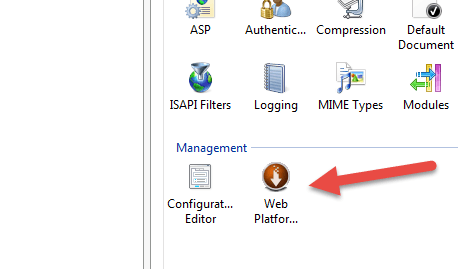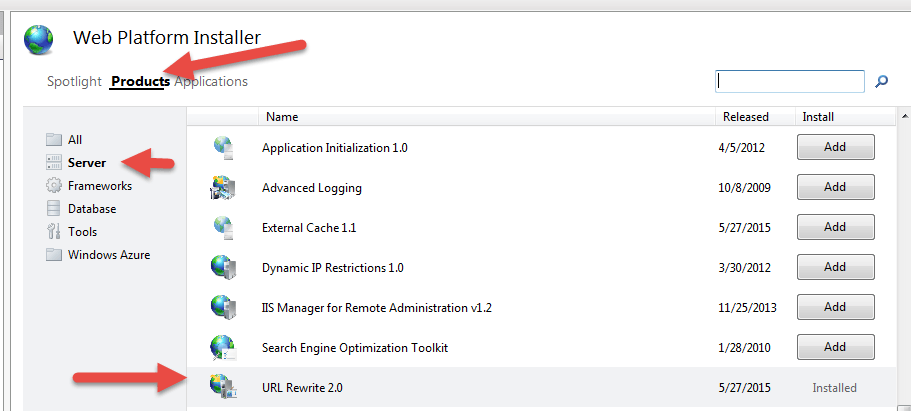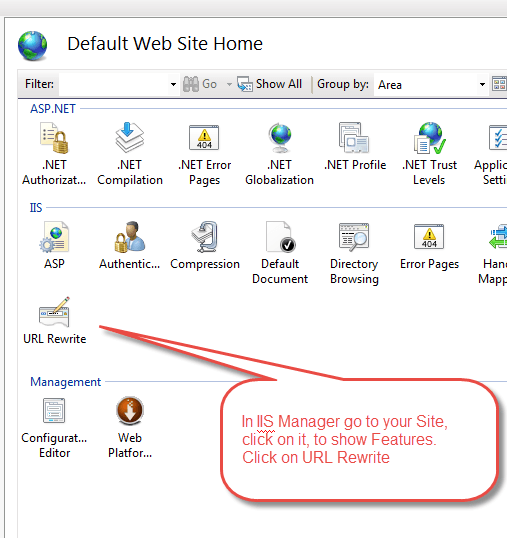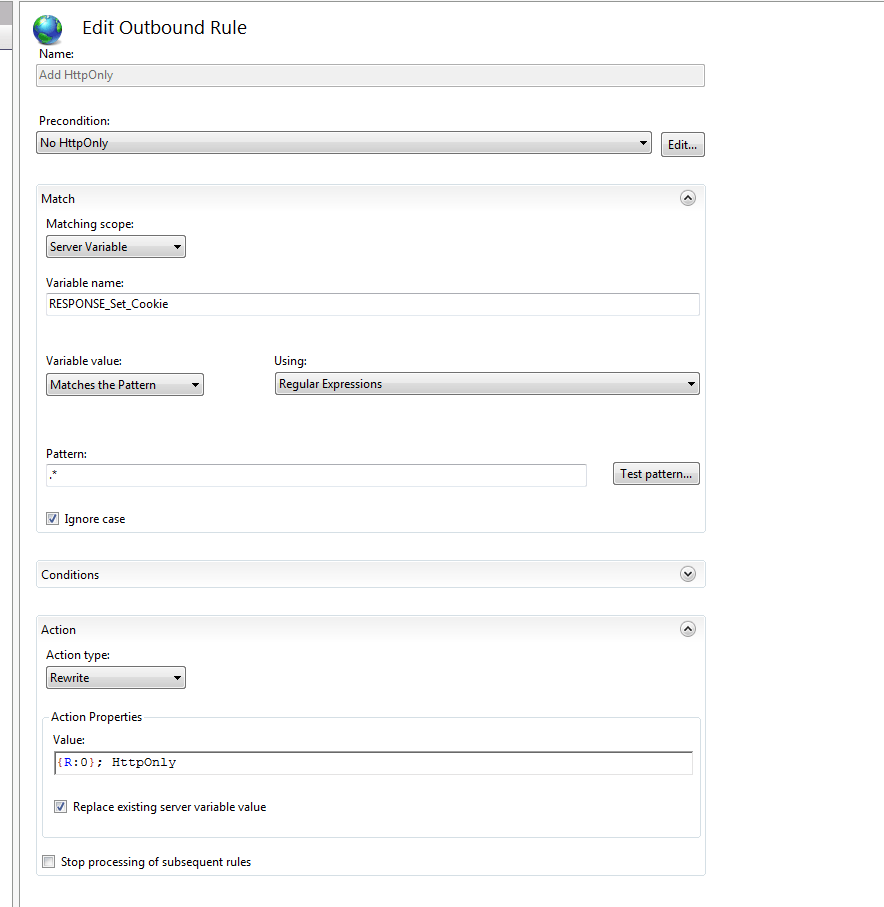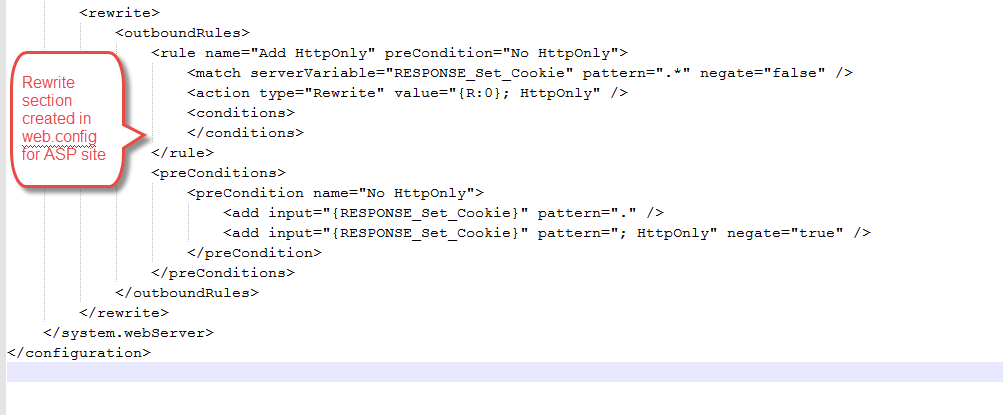Установка HTTPONLY для классического файла cookie сеанса Asp
Кто-нибудь знает точно, как установить HTTPONLY на классические файлы cookie сеанса ASP?
Это последнее, что было отмечено при сканировании уязвимостей и нуждается в исправлении как можно скорее, поэтому любая помощь приветствуется.
~~~ НЕМНОГО БОЛЬШЕ ИНФОРМАЦИИ О МОЕЙ ПРОБЛЕМЕ ~~~
Может кто-нибудь, пожалуйста, помогите мне с этим?
Мне нужно знать, как установить HTTPONLY на файл cookie ASPSESSION, созданный по умолчанию из ASP и IIS.
Это файл cookie, автоматически создаваемый сервером для всех страниц ASP.
При необходимости я могу установить HTTPONLY для всех файлов cookie на сайте.
Любая помощь о том, как это сделать, будет очень цениться.
Спасибо
Спасибо Эллиотт
8 ответов
Microsoft включает пример использования фильтра ISAPI для всех исходящих файлов cookie: http://msdn.microsoft.com/en-us/library/ms972826
или можно переписать URL http://forums.iis.net/p/1168473/1946312.aspx
<rewrite>
<outboundRules>
<rule name="Add HttpOnly" preCondition="No HttpOnly">
<match serverVariable="RESPONSE_Set_Cookie" pattern=".*" negate="false" />
<action type="Rewrite" value="{R:0}; HttpOnly" />
<conditions>
</conditions>
</rule>
<preConditions>
<preCondition name="No HttpOnly">
<add input="{RESPONSE_Set_Cookie}" pattern="." />
<add input="{RESPONSE_Set_Cookie}" pattern="; HttpOnly" negate="true" />
</preCondition>
</preConditions>
</outboundRules>
</rewrite>
Если у вас есть IIS7 +, вы должны убедиться, что модуль перезаписи URL установлен. Вы можете установить его с помощью установщика веб-платформы. Установщик веб-платформы можно найти в представлении функций вашего веб-сайта. Вам нужно запустить IIS Manager от имени администратора.
Нажмите на установщик веб-платформы в представлении функций для своего веб-сайта:
Убедитесь, что продукт сервера перезаписи URL установлен. Если это не так, то установите его.
С установленным продуктом сервера перезаписи URL вы можете использовать функцию перезаписи URL на своем веб-сайте, чтобы добавить правило для добавления HttpOnly для файлов cookie идентификатора сеанса.
Вы должны увидеть, если он еще не существует, файл web.config, созданный для вашего сайта ASP. он будет иметь следующее содержимое:
Если вы используете Firebug в Firefox для проверки своих файлов cookie, вы должны увидеть установленный флаг HttpOnly:
Response.AddHeader "Set-Cookie", "CookieName=CookieValue; path=/; HttpOnly"
Я скомпилировал пример фильтра ISAPI от Microsoft. Это решило мою проблему.
ISAPI DLL здесь
Не стесняйтесь скачать.
Задать файл cookie сеанса ASP как HttpOnly можно в файле web.config, используя URLrewrite:
<rewrite>
<outboundRules>
<rule name="Secure ASP session cookie">
<match serverVariable="RESPONSE_Set_Cookie" pattern="ASPSESSIONID(.*)" negate="false" />
<!--<action type="Rewrite" value="ASPSESSIONID{R:1}; HttpOnly; Secure" />-->
<action type="Rewrite" value="ASPSESSIONID{R:1}; HttpOnly" />
</rule>
</outboundRules>
</rewrite>
Также можно использовать URLrewrite, чтобы сделать все куки HttpOnly / Secure, но иногда вам нужны куки, чтобы быть читаемыми в JavaScript, поэтому вот коллекция функций и подпрограмм, которые я написал некоторое время назад для создания обычных куки, которые могут включать или отключать "HttpOnly". "и" Безопасный ":
' *********************************************************************************************************
' Set a cookie
' *********************************************************************************************************
sub set_cookie(cookie_name,cookie_value,cookie_path,http_only,secure,expire)
Dim cookie_header, split_expire, expire_value
' Set the cookie name and value. The value must be URL encoded.
cookie_header = cookie_name & "=" & server.URLEncode(cookie_value) & "; "
' To set cookies that can be accessed by sub domains, you need to specify the domain as
' ".mydomain.com". If no domain is specified then the cookie will be set as "host only",
' and only be accessible to the domain it was set on. Un-comment to disable host only:
'cookie_header = cookie_header & "Domain=.mydomain.com; "
' Check the expire value for a specific expiry length (e.g; "1 year")
' For session cookies, the expiry should be set to null.
if NOT isDate(expire) AND NOT isNull(expire) then
' Remove any double spaces and trim the value.
expire = replace(expire," "," ")
expire = trim(expire)
' Split on space to separate the expiry value from the expiry unit.
split_expire = split(expire," ")
' A uBound value of 1 is expected
if uBound(split_expire) = 1 then
expire_value = split_expire(0)
if NOT isNumeric(expire_value) then exit sub
expire_value = int(expire_value)
select case lCase(split_expire(1))
case "minute","minutes"
expire = DateAdd("n",expire_value,Now())
case "hour","hours"
expire = DateAdd("h",expire_value,Now())
case "day","days"
expire = DateAdd("d",expire_value,Now())
case "week","weeks"
expire = DateAdd("ww",expire_value,Now())
case "month","months"
expire = DateAdd("m",expire_value,Now())
case "year","years"
expire = DateAdd("yyyy",expire_value,Now())
case else
' unknown expiry unit, exit sub
exit sub
end select
else
' Unexpected uBound. This means no space was included when specifying the expiry length
' or multiple spaces were included.
exit sub
end if
end if
' Set the expiry date if there is one. If the expiry value is null then no expiry date will be set and
' the cookie will expire when the session does (a session cookie).
' The expiry date can only be UTC or GMT. Be sure to check your servers timezone and adjust accordingly.
if isDate(expire) then
' The cookie date needs to be formatted as:
' WeekDayName(shortened), day-monthName(shortened)-year timestamp(00:00:00) GMT/UTC
expire = cDate(expire)
cookie_header = cookie_header & "expires=" &_
weekday_name(WeekDay(expire),true) & ", " &_
ZeroPad(Day(expire)) & "-" &_
month_name(Month(expire),true) & "-" &_
year(expire) & " " &_
timeFromDate(expire) & " UTC; "
end if
cookie_header = cookie_header & "path=" & cookie_path & "; "
' HttpOnly means cookies can only be read over a HTTP (or HTTPS) connection.
' This prevents JavaScript from being able to read any cookies set as HttpOnly.
' HttpOnly should always be used unless you're setting a cookie that needs to
' be accessed by JavaScript (a CSRF token cookie for example).
if http_only then
cookie_header = cookie_header & "HttpOnly; "
end if
' A "secure" cookie means the cookie can only be accessed over a HTTPS connection.
' If we try to create a secure cookie over a none HTTPS connection it will be
' rejected by most browsers. So check the HTTPS protocol is ON before setting a
' cookie as secure. This check is particularly useful when running on a localhost,
' most localhosts don't use HTTPS, so trying to set a Secure cookie won't work.
if secure AND uCase(request.ServerVariables("HTTPS")) = "ON" then
cookie_header = cookie_header & "Secure; "
end if
' Add the header and remove the trailing ";"
response.AddHeader "Set-Cookie",left(cookie_header,len(cookie_header)-2)
end sub
' *********************************************************************************************************
' Delete a cookie
' *********************************************************************************************************
sub delete_cookie(cookie_name)
' There is no header for deleting cookies. Instead, cookies are modified to a date that
' has already expired and the users browser will delete the expired cookie for us.
response.AddHeader "Set-Cookie",cookie_name & "=; " &_
"expires=Thu, 01-Jan-1970 00:00:00 UTC; path=/"
end sub
' *********************************************************************************************************
' When the LCID is set to 1033 (us) vbLongTime formats in 12hr with AM / PM, this is invalid for a cookie
' timestamp. Instead, we use vbShortTime which returns the hour and minute as 24hr with any LCID, then use
' vbLongTime to get the seconds, and join the two together.
' *********************************************************************************************************
function timeFromDate(ByVal theDate)
Dim ts_secs : ts_secs = split(FormatDateTime(theDate,vbLongTime),":")
if uBound(ts_secs) = 2 then
timeFromDate = FormatDateTime(theDate,vbShortTime) & ":" & left(ts_secs(2),2)
else
timeFromDate = "00:00:00"
end if
end function
' *********************************************************************************************************
' WeekDayName and MonthName will return a value in the native language based on the LCID.
' These are custom functions used to return the weekday and month names in english,
' reguardless of the LCID
' *********************************************************************************************************
function weekday_name(weekday_val, shorten)
select case weekday_val
case 1
if shorten then weekday_name = "Sun" else weekday_name = "Sunday"
case 2
if shorten then weekday_name = "Mon" else weekday_name = "Monday"
case 3
if shorten then weekday_name = "Tue" else weekday_name = "Tuesday"
case 4
if shorten then weekday_name = "Wed" else weekday_name = "Wednesday"
case 5
if shorten then weekday_name = "Thu" else weekday_name = "Thursday"
case 6
if shorten then weekday_name = "Fri" else weekday_name = "Friday"
case 7
if shorten then weekday_name = "Sat" else weekday_name = "Saturday"
end select
end function
function month_name(month_val, shorten)
select case month_val
case 1
if shorten then month_name = "Jan" else month_name = "January"
case 2
if shorten then month_name = "Feb" else month_name = "February"
case 3
if shorten then month_name = "Mar" else month_name = "March"
case 4
if shorten then month_name = "Apr" else month_name = "April"
case 5
month_name = "May"
case 6
if shorten then month_name = "Jun" else month_name = "June"
case 7
if shorten then month_name = "Jul" else month_name = "July"
case 8
if shorten then month_name = "Aug" else month_name = "August"
case 9
if shorten then month_name = "Sep" else month_name = "September"
case 10
if shorten then month_name = "Oct" else month_name = "October"
case 11
if shorten then month_name = "Nov" else month_name = "November"
case 12
if shorten then month_name = "Dec" else month_name = "December"
end select
end function
' *********************************************************************************************************
' Prefix a 1 digit number with a 0. Used in date formatting
' *********************************************************************************************************
function zeroPad(theNum)
if len(theNum) = 1 then
zeroPad = cStr("0" & theNum)
else
zeroPad = theNum
end if
end function
Примеры:
' **************************************************************************************************************
' set_cookie(COOKIE NAME, COOKIE VALUE, COOKIE PATH, HTTPONLY (BOOLEAN), SECURE (BOOLEAN), EXPIRY DATE / LENGTH)
' **************************************************************************************************************
' Expire on a specific date:
call set_cookie("cookie_name1","cookie value","/",true,true,"15 Jan 2019 12:12:12")
call set_cookie("cookie_name2","cookie value","/",true,true,"15 January 2019 12:12:12")
call set_cookie("cookie_name3","cookie value","/",true,true,"Jan 15 2019 12:12:12")
call set_cookie("cookie_name4","cookie value","/",true,true,"January 15 2019 12:12:12")
call set_cookie("cookie_name5","cookie value","/",true,true,"Jan 15 2019")
call set_cookie("cookie_name6","cookie value","/",true,true,"January 15 2019")
' Expire when the session ends (a sesson cookie):
call set_cookie("cookie_name7","cookie value","/",true,true,null)
' Specify an expiry length:
call set_cookie("cookie_name8","cookie value","/",true,true,"20 minutes")
call set_cookie("cookie_name9","cookie value","/",true,true,"1 hour")
call set_cookie("cookie_name10","cookie value","/",true,true,"10 days")
call set_cookie("cookie_name11","cookie value","/",true,true,"3 weeks")
call set_cookie("cookie_name12","cookie value","/",true,true,"1 year")
' Delete a cookie:
call delete_cookie("cookie_name")
' This would also work for deleting a cookie:
call set_cookie("cookie_name","","/",false,false,"-1 year")
Старый , но хороший, добавьте это в глобально включенный asp:
Dim AspSessionCookie
AspSessionCookie = Request.ServerVariables("HTTP_COOKIE")
If instr(AspSessionCookie,"ASPSESSIONID") > 0 Then
AspSessionCookie = "ASPSESSIONID" & Split(AspSessionCookie,"ASPSESSIONID")(1)
If InStr(1,AspSessionCookie,";") then
AspSessionCookie = Split(AspSessionCookie,";")(0)
End If
Response.AddHeader "Set-Cookie", AspSessionCookie & ";HttpOnly"
End If
Веб-платформа больше не используется. Чтобы установить перезапись URL-адреса, загрузите установщик непосредственно с веб-сайта IIS https://www.iis.net/downloads/microsoft/url-rewrite .
Эта страница содержит много информации, которая имеет отношение к вашей проблеме.
.NET 1.1 не добавляет HttpOnly потому что это еще не было изобретено.
Если ваше приложение будет работать под.NET 2.0 (я переместил несколько сайтов Classic ASP на 2.0 практически без изменений) HttpOnly установлен по умолчанию.
Если я правильно его прочитал, вы можете получить файл cookie сеанса и добавить ; HttpOnly; к этому. Он дает пример Java:
String sessionid = request.getSession().getId();
response.setHeader("SET-COOKIE", "JSESSIONID=" + sessionid + "; HttpOnly");
Наконец, он предлагает:
если изменения кода невозможны, брандмауэры веб-приложений можно использовать для добавления HttpOnly в сеансовые файлы cookie.
Отредактировано, чтобы добавить: для тех, кто думает, что переход на.NET (который может вместить большую часть классического ASP-кода без изменений) слишком радикальное изменение, чтобы получить такую маленькую функцию, мой опыт работы с фильтрами ISAPI заключается в том, что они тоже могут быть серьезной проблемой и в некоторых распространенных ситуациях (виртуальный хостинг) их вообще нельзя использовать.

